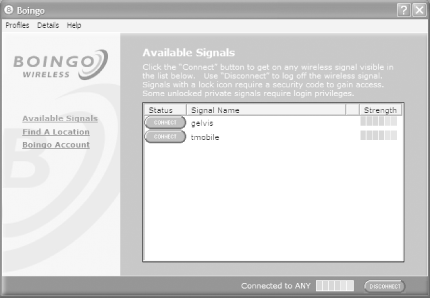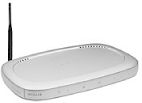3.1 Wireless Hotspots
| As more users equip their portable computers with Wi-Fi, opportunities have emerged for anyone who can bring a DSL line and access point into a public space such as a coffee shop, airport, or public library. Some people will set up an access point and charge by the hour; others will charge nothing, just to attract customers or keep them a little longer; some, such as a library, will set it up to make information more accessible. A venue with this kind of public access point is known as a wireless hotspot. The number of wireless hotspots is growing rapidly. Today, you can easily find wireless hotspots in hotels, airports, coffee shops, and metropolitan areas.
If you want to know out whether a particular area has a wireless hotspot, you can search for one at the following web sites:
In the following sections, I discuss some of the wireless hotspots provided by commercial service providers as well as end users and community groups. 3.1.1 Wireless Internet Service ProvidersLike the conventional Internet Service Provider (ISP), a Wireless Internet Service Provider (WISP) provides Internet access, albeit wirelessly (from the client to the access point). These providers ranges from the big names, such as T-Mobile, WayPort, and Surf and Sip, to the independent wireless operators found in your neighborhood coffee houses and bars. When you connect to a WISP's hotspot, the first thing you should do is open up a web browser and try to visit a site outside the WISP's network, such as www.oreilly.com. This is because many WISPs divert all web traffic to a sign-on page called a captive portal (see Figure 3-1). Until you sign up for the service and pay with your credit card, your access is limited to the captive portal and possibly some portions of the WISP's own web site. Figure 3-1. T-Mobile's captive portal 3.1.1.1 T-Mobile HotSpotT-Mobile HotSpot (http://www.t-mobile.com/hotspot/) is one of the wireless service providers in the U.S. It has coverage in over 2,000 locations such as airports, Starbucks Coffee, and Borders bookstores. Each location is equipped with a T1 line, providing speedy access to the Internet. The pricing plan is flexible you can either sign up for an unlimited monthly subscription plan that starts at $29.95 or pay as you go for 10 cents per minute. You can download a list of T-Mobile Hotspots at http://locations.hotspot.t-mobile.com/page6a.asp.
3.1.1.2 Surf and SipSurf and Sip (http://www.surfandsip.com/) provides high-speed Internet access at locations such as cafes, hotels, restaurants, and other public places. Surf and Sip has flexible service plans ranging from monthly subscription to pay-as-you-go pricing.
If you run a business, you can also collaborate with Surf and Sip to offer wireless Internet access at your business location. Surf and Sip will provide all the technology and materials needed and best of all, you get a cut of the revenue generated. 3.1.1.3 WayPortWayPort has very good coverage in major hotels (such as the Four Seasons, Loews, Sheraton, Radisson, Hilton, Marriott, Embassy Suites, and Wyndham) and airports (including Dallas/Fort Worth, Atlanta Hartsfield, Chicago O'Hare, New York LaGuardia, Seattle-Tacoma, San Jose, and more) in the U.S. For a list of all WayPort wireless hotspot locations, visit http://www.wayport.com/locations. With so many WISPs offering wireless Internet access, how do you identify one? The easiest way is to look for a sign or logo in the coffee shop or airport. Figure 3-2 shows the signage of T-Mobile, Surf and Sip, and WayPort. Figure 3-2. The signage of the various WISPs
3.1.2 Wireless AggregatorsWith the proliferation of WISPs and hotspot operators, interoperability becomes crucial. You want to be able to connect wirelessly whenever there is a wireless hotspot, regardless of the WISP that is providing the network. A wireless network aggregator provides uniform access to all the different operators that partner with the aggregator. It is like roaming on your mobile phone, except without the exorbitant fees. Instead of expecting you to sign up with all the phone companies in the countries that you visit, your local phone company works with operators from different countries to provide telephone service outside of your phone company's service areas. Boingo.com is a wireless network aggregator. Boingo provides several price plans starting from $7.95 for two Connect days (a Connect day is 24 hours of unlimited usage per location, starting from the moment you first connect) to $49.95 for monthly unlimited usage. Using Boingo's software, you can configure your computer to wirelessly connect to the nearest hotspot. As a user, you are shielded from the intricacies of locating the right network and remembering various usernames and passwords. You can search for over 1,300 hotspots covering 300 cities and 43 states at http://www.boingo.com/search.html. Figure 3-3 shows the Boingo software finding two wireless networks in your immediate vicinity. Figure 3-3. Boingo's software locating two networks 3.1.3 Wireless Community NetworksWhen I first visited the U.S. many years ago, I came across one interesting fact. I realized that in most places it is difficult to find a public washroom you can usually find one in restaurants or big shopping malls only. Back in Singapore, washrooms are easy to find, and access to most of them is free. Think about it you pay for water at home, but in public washrooms, it is free (at least to you). If you apply this economic model to Internet access, why not have free Internet access in public places?
The idea that I have to pay for Internet access while I am on the road (or even sipping my coffee at a coffee house) still baffles me. The coffee house should provide free Internet access, just like using the water in the washroom is free. Commercial DSL can be had for well under $100 a month in many parts of the United States, and an access point is a one-time expense of under $100. So why not simply use free Wi-Fi as a way to lure customers? Fortunately, many people think likewise and set up free hotspots in their businesses. Some grassroots groups take this a few steps further and form wireless community networks. Figure 3-4. The Wi-Fi Zone logo The concept of a wireless community network is simple. If you have a broadband connection to the Internet, why not share it? You can share the connection by connecting it to an access point and allowing your neighbors to connect to it as well. If many people do this, coordinate their efforts, and provide a central location where users can learn about the service, it's a community network.
You find the various wireless communities that are out there by visiting the WirelessCommunities site at http://www.personaltelco.net/index.cgi/WirelessCommunities. 3.1.4 Sharing BandwidthIf you often travel in groups and want to minimize the cost of getting online, bring a wireless access router along with you the next time you travel. The NetGear MR814 802.11b Cable/DSL Wireless Router is a good choice due to its slim design (see Figure 3-5). Figure 3-5. The NetGear MR814 802.11b Cable/DSL Wireless Router Instead of connecting your notebook computer directly to a hotel's broadband connection, connect your wireless router to it and share it wirelessly with your colleagues. This way, all of your traveling companions can access the network at the same time. If you don't feel like carrying a router with you when you travel, you can also share a connection using an ad-hoc network (see Chapter 5). |
EAN: N/A
Pages: 92
